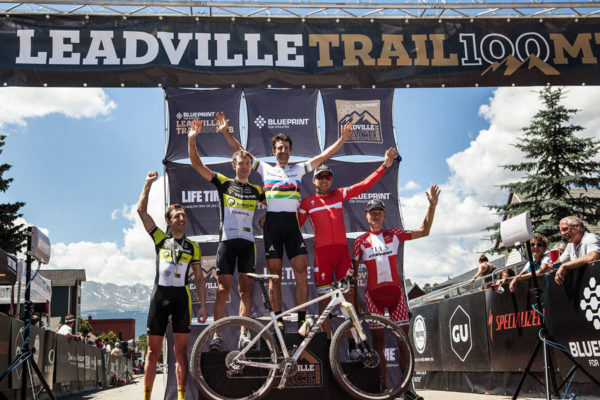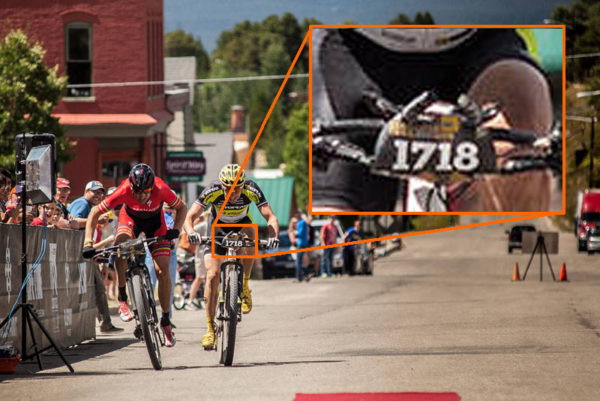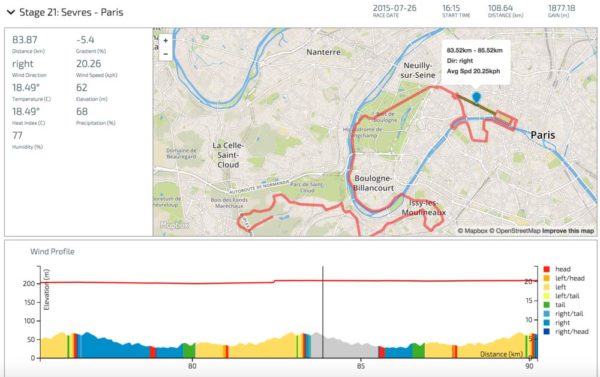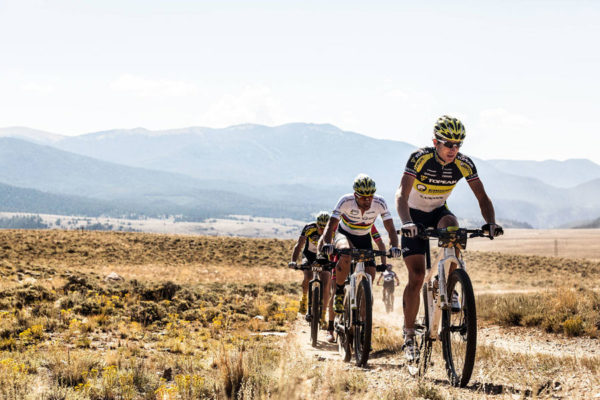
Every once in a while we get a call from Jeremiah Bishop. Bishop’s one of the longest running pro mountain bikers out there, having remained at a top level for well over a decade and continually finding new ways of pushing himself. I’ve raced with him (or, more accurately, seen him racing) at various events over the years, and not only is he ridiculously fast, he’s also supremely approachable and always has an interesting story on what he’s up to with training, racing or coaching.
So, a few weeks ago, he reached out to talk about how he’s gunning for a new course record at the Leadville Trail 100 this year. But with so many pros trying to one up each other there, he knew he’d have to do more than have the performance of his life. He’d have to come up with some new tricks…
“It’s an interesting race because Lance (Armstrong) made it so popular, but it’s always been about the glory,” Bishop said”. There’s no prize money, but, from the race standpoint, it’s a really unique event. For 2015, the Team Topeak-Ergon crew made it our mission to break the six hour barrier and set a new course record.”
After double checking the racer’s GPS chips and contesting the 6:00:02 race clock, last year saw Bishop’s teammates Alban Lakata and Kristian Hynek finish in 5:58:35. They didn’t know if it was possible to do it under six hours, but all of the preparation paid off. Right behind them, Christoph Sauser (Specialized) and Bishop worked together to finish in 6:00:XX. “My job was to block for Alban, and Sauser and I probably could have caught them,” Bishop said, “But that year’s team strategy was to put Alban at the front.” (Editor’s Note: Team Topeak-Ergon has a very cool storyboard site of the 2015 race here)
“This year, there’s a lot of top pros gunning for breaking that six hour record,” he continued, stating that they want to bring all of their team members across the line in sub six. “I think I can do it by optimizing the gear. When you’re looking at a 17.8mph average to beat six hours, that’s wicked fast. Most mountain bike races we do, the average is 12-14mph. But Leadville is unique in that it’s almost like a half mountain bike race, half road race.”
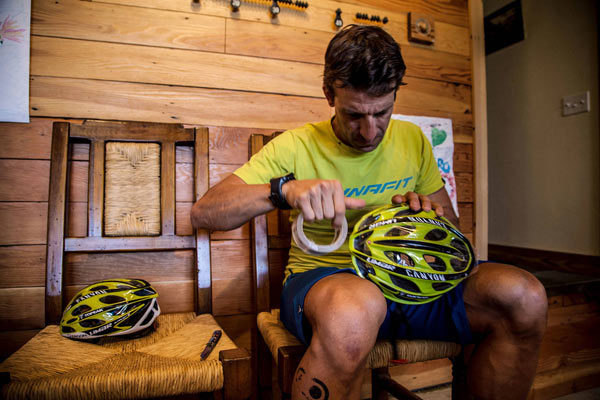
We’ve been testing aero helmets from Limar (the 007 model), even going so far as to tape over some of the air vents, and a couple other minimal things, but meeting up with Robby should yield some interesting new ideas. Things like where you put the number plate, whether you angle it up or down, bend it or cut the corners. Mountain bike racing doesn’t have any restrictions on fairings, so we’ll look at the shapes of components and gear.
“But the biggest part of it is the rider position. Last year at Leadville, I tried some mini aero bars and they were really effective.
“The aero bars on the mountain bike came about because I wrecked during a photo shoot and had to get stitches in my hand. But I had some mini aero bars from an uphill TT I had done years ago, so I put them on my bike just to get a comfortable hand position so I could keep training. On my next ride, I was going at an endurance pace and noticed that I was going a full kilometer an hour faster at the same output. Over a race like Leadville, that translates to a 2km difference, which is like being in another time zone at the finish.
“We can use that at Cape Epic, TransAlp, Breck Epic and marathon races throughout the world. Once you have those gains, you can keep them, and they add up to seconds and minutes.
“During a mountain bike race, normalized power is close to 300 watts, and marathon races are 340-350 watts. So when you’re putting out that kind of effort, aerodynamics are going to make a huge difference.
“For this year, a lot of what I’m looking at optimizing won’t require fabrication, so it’s things like optimizing the placement of things on the bike. But I’m talking to SRAM about modifying their wheels to use carbon fairings like what you’d find on their Zipp road wheels. And things like dropping the post down to get lower on the flat descents, which is like free speed.”
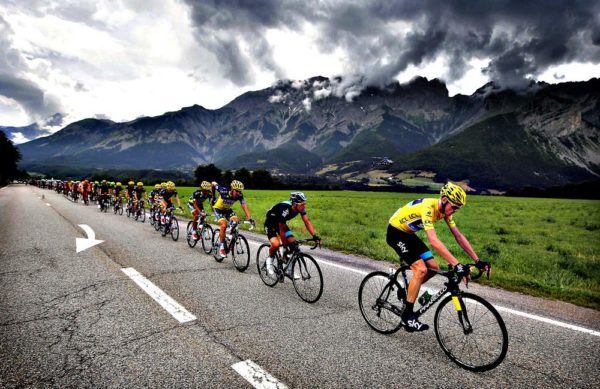
More on that dropper post thing in a minute. Bishop admits that a lot of what he’s been looking at so far produced or came from anecdotal results. To put a little more science behind it, he turned to Robby Ketchell, the aerodynamics guru that’s worked with Team Sky to streamline Chris Froome and the rest of the riders. Ketchell’s company, Winning Algorithms, produces both hardware and software to analyze the weather and course conditions and make specific aerodynamic recommendations on equipment and rider position.
“I’ve worked with Team Sky and all of their stuff for the Tour,” Ketchell told us by phone. “So Bishop and I were talking about what he could do to improve aerodynamics on a mountain bike. One of the biggest things I suggested was getting his face as close as possible to his forearms. On a mountain bike, that’s much easier because the front end is already higher, so you can reduce that frontal drag and still have good power output.
“But you have to be strategic about it. You don’t need to be aero when you’re going too slow.
“I’ve done Leadville four times, and there are really key moments when you can be aero on that course. Like the road section right after you come out of Powerlines. And it depends on what type of people you’re with, whether or not you can draft, and whether it makes more sense to stay with that pack or tuck in and head out on your own. At the start, you’re with a big pack, but after that you’re on a big road section, so that decision has to be made. I think aerodynamics matter the most after you come down into the Fish Hatchery section.
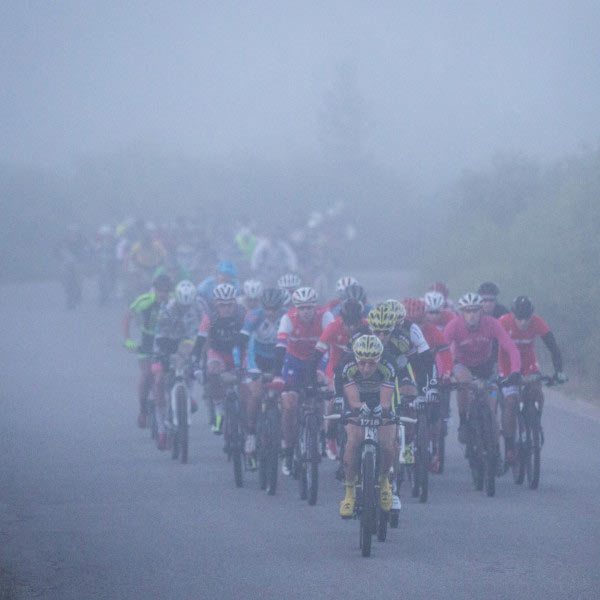
“(Jeremiah) tried all kinds of crazy positions, putting handles in different places and trying to get his hands really low. We talked it through and I helped him find the right positions -how to mold his body- for where he was on the course and how he’d be riding.”
The Takeaway? Ketchell says the number one thing people think is that that lower you get, the more aero you are. So you can do that two ways, by bringing your head really low, or bringing your arms up close to you. Most people ride with their head too high – the best position is resting your forearms on the handlebar and tucking your head down as close as you can without compromising your safety (i.e. ability to see where you’re going). The “hack” is really just knowing that you can bring your hands higher and still obtain the aero benefits.
“That, and a lot of people ride with bars that are too wide,” Ketchell continues. “Getting the width to a natural state is best because it reduces frontal area and puts the arms in a better position. Even on the road bike, most people are more aero riding on the hoods because their forearms are parallel to the road, which is more streamlined than having them almost perpendicular to the road when in the drops. It’s like sticking your arm straight out your window versus holding it alongside the car while driving, it’s a dramatic difference.”
Ketchell’s conversations with Bishop were limited to body position. When asked if he had any tips or tricks for the bike and components, he mentioned saddle height.
“The nice thing about mountain bikes is that the saddle is slightly lower than on road bikes, so if you can ride with a lower saddle height, you can get into a more streamlined positioned. Bishop’s been experimenting with a dropper post on the descents, which lets him get really low and aero without resorting to a dangerous position like trying to sit on the top tube.
“He’s the one that brought this to my attention for road descents, and it makes a lot of sense. It becomes an engineering problem to integrate into the bike, but I think we’ll see that in the future of road bikes for sure. Especially since the bikes are too light (for UCI regulations) and you’ve got to add things to them to meet the minimum anyway.”
And any tricks he can share about the Team Sky bikes? “You’re a lot more limited with what you can do to the bikes and rider in road racing. So we were modeling the weather forecasts, looking at a 10 year history for given road segments, and analyzing course conditions. Fine tuning equipment selection to the wind, weather and course is what we were really doing. That and optimizing the equipment like clothing and helmets and teaching the riders about strategic positioning. You can’t hold the aero position for the entire race, so knowing when to use it in the strongest headwinds or other specific sections is what were were doing with Team Sky.”
Huge thanks to Jeremiah and Robby for their time!
